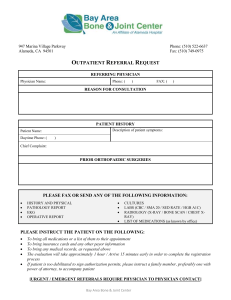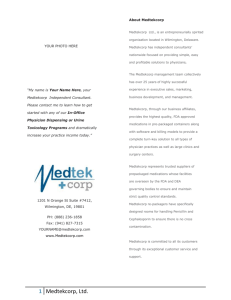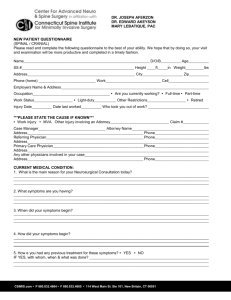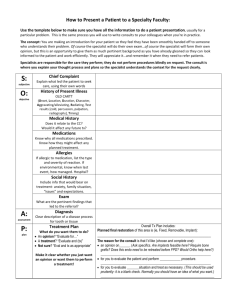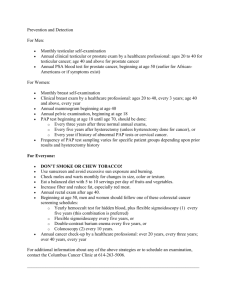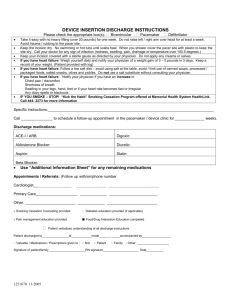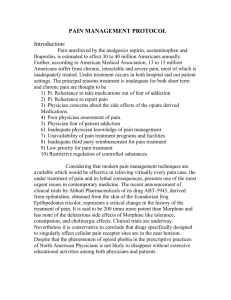ACE Care Plan Guidelines
advertisement
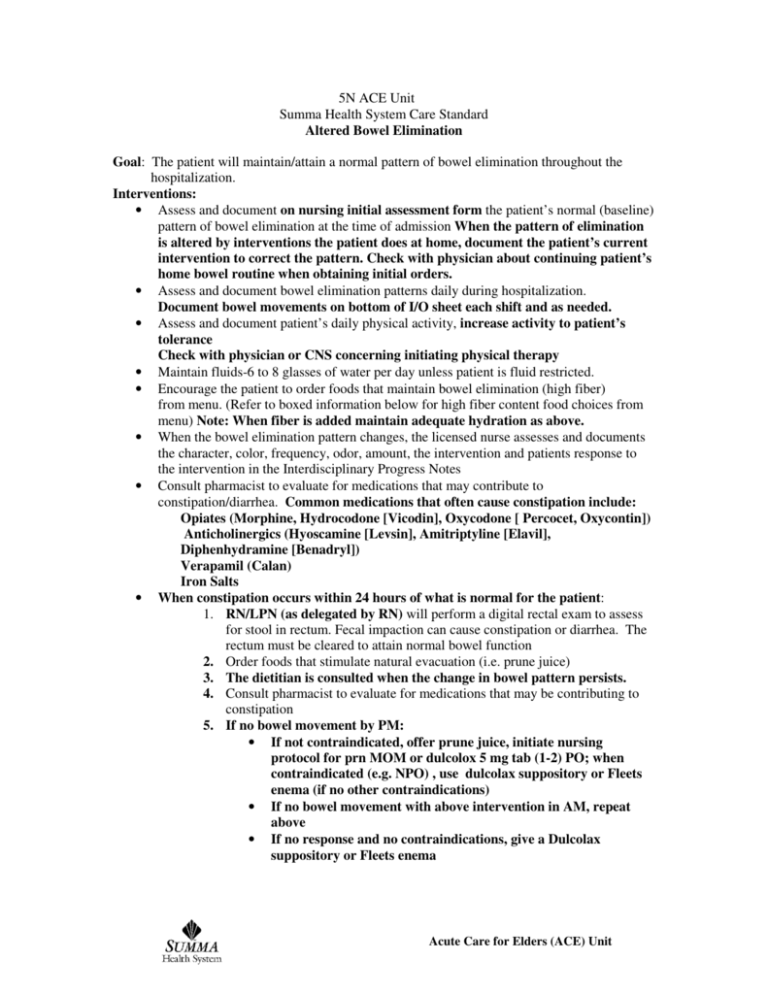
5N ACE Unit Summa Health System Care Standard Altered Bowel Elimination Goal: The patient will maintain/attain a normal pattern of bowel elimination throughout the hospitalization. Interventions: • Assess and document on nursing initial assessment form the patient’s normal (baseline) pattern of bowel elimination at the time of admission When the pattern of elimination is altered by interventions the patient does at home, document the patient’s current intervention to correct the pattern. Check with physician about continuing patient’s home bowel routine when obtaining initial orders. • Assess and document bowel elimination patterns daily during hospitalization. Document bowel movements on bottom of I/O sheet each shift and as needed. • Assess and document patient’s daily physical activity, increase activity to patient’s tolerance Check with physician or CNS concerning initiating physical therapy • Maintain fluids-6 to 8 glasses of water per day unless patient is fluid restricted. • Encourage the patient to order foods that maintain bowel elimination (high fiber) from menu. (Refer to boxed information below for high fiber content food choices from menu) Note: When fiber is added maintain adequate hydration as above. • When the bowel elimination pattern changes, the licensed nurse assesses and documents the character, color, frequency, odor, amount, the intervention and patients response to the intervention in the Interdisciplinary Progress Notes • Consult pharmacist to evaluate for medications that may contribute to constipation/diarrhea. Common medications that often cause constipation include: Opiates (Morphine, Hydrocodone [Vicodin], Oxycodone [ Percocet, Oxycontin]) Anticholinergics (Hyoscamine [Levsin], Amitriptyline [Elavil], Diphenhydramine [Benadryl]) Verapamil (Calan) Iron Salts • When constipation occurs within 24 hours of what is normal for the patient: 1. RN/LPN (as delegated by RN) will perform a digital rectal exam to assess for stool in rectum. Fecal impaction can cause constipation or diarrhea. The rectum must be cleared to attain normal bowel function 2. Order foods that stimulate natural evacuation (i.e. prune juice) 3. The dietitian is consulted when the change in bowel pattern persists. 4. Consult pharmacist to evaluate for medications that may be contributing to constipation 5. If no bowel movement by PM: • If not contraindicated, offer prune juice, initiate nursing protocol for prn MOM or dulcolox 5 mg tab (1-2) PO; when contraindicated (e.g. NPO) , use dulcolax suppository or Fleets enema (if no other contraindications) • If no bowel movement with above intervention in AM, repeat above • If no response and no contraindications, give a Dulcolax suppository or Fleets enema Acute Care for Elders (ACE) Unit • If no response to intervention by third day, inform physician, suggest order for Sorbitol 70% 30 ml qd—hold if more than 1 BM, the previous day • Special Considerations: 1. Diverticulosis patients: these patients need increased fiber with no nuts, seeds, or popcorn. Check that patient orders high fiber foods. Note: When fiber is added maintain adequate hydration as above. If Metamucil is not ordered, ask physician to consider adding 2. Diverticulitis: these patients need decreased fiber (Low residue diet) Check that a low residue diet is ordered 3. Narcotics use---when patients are taking narcotics on a scheduled basis: Ask physician for order for Senokot S 1 tab qd and prn or sorbitol 70% 30ml qd–hold if diarrhea 4. Iron Supplementation—when iron dosage for a patient is greater than once a day, monitor for constipation. When constipation occurs notify physician, check if dose can be decreased to once a day, if it cannot, suggest the order for sorbitol 70% 30 ml qd –hold if diarrhea. • When a patient develops diarrhea 1. Evaluate if patient has a history of irritable bowel syndrome, colitis, Crohn’s or short gut disease 2. When the patient is on broad-spectrum antibiotics, inform physician of diarrhea and suggest order to test stool for C diff/O&P 3. Suggest use of BRAT (Bananas, Rice, Applesauce, Toast) diet for 2-3 days 4. Order yogurt (or light yogurt for diabetic patient) 5. Increase by mouth fluids if patient can tolerate 6. Assess for dehydration, inform physician and suggest IV fluid order if appropriate 7. Consult pharmacy to evaluate if medications could be contributing 8. Consult nutrition to evaluate if foods could be contributing e.g. lactose intolerance 9. Suggest to physician order for loperamide (Immodium) 4 mg x 1 then 2 mg after each loose stool up to a maximum of 16 mg/day (8 capsules / day) 10. If cholestyramine (Questran) is ordered, give medications 1 hr before Questran and 4hours after 11. If diarrhea occurs with tube feeding, consult dietary to evaluate tolerance to tube feeding, ask physician for a Metamucil order qd FOODS with increased fiber (from room service menu) Oatmeal Raisin bran Shredded wheat Bran Flakes Whole wheat bread Rye bread Banana bread Vegetable soup Pickles Caesar Salad Coleslaw Relish plate Stir fry-vegetable of chicken over rice Carrots Corn Green beans Butternut squash Broccoli Zucchini Yellow squash Prune juice Baked potato Baked sweet potato Stewed prunes Oatmeal raisin cookie Fresh fruit cup Grapefruit sections Fresh apple, banana, and orange 12/03 5N Bowel elim Acute Care for Elders (ACE) Unit 5 N ACE Unit Summa Health System Care Guideline Pain/Comfort Goal: To keep pain rating at or below the goals established with the patient and/or family To maintain baseline function and cognition To maintain/attain adequate sleep/rest patterns Interventions: • Establish a pain goal with patient and/or family (generally a pain rating of 3 or less). If pain rating is not attained reassess the goal based upon the rating scale and the side effects of the medications. • Use the pain rating scale best suited for the patients use (WILDA, Wong Baker Faces, Cognitively Impaired Patient Scale). For the older adult with moderate to severe dementia or who is nonverbal assess pain via direct observation or history from caregiver. • Accept the patient’s word about the pain and intensity. Clarify the type of pain and ask what interventions have been used successfully in the past (e.g. arthritis pain that responded to heat to the affected joint) • Record pain intensity in graphics and on nursing assessment form with vital signs and with each pain intervention. • Instruct the patient to report pain promptly so that relief measures can be started before pain becomes severe. • Report unrelieved pain above the goal to the physician for follow-up. For chronic unrelieved pain: consider spiritual consult evaluation for depression palliative care team consult anesthesia consult referral to outpatient pain clinic (CFGH). • Use non pharmacological methods of pain relief whenever possible: Massage, back rubs post turning and at bed time, repositioning, pillow support, K pads (if ordered), cold application, ROM, distraction with music, TV, TENs units (if ordered). • Consult pharmacist for review/recommendations for pain management. • Encourage continued mobility and self-care. Consult Physical Therapy/Occupational Therapy for exercises patient may use to avoid precipitating pain or dysfunction. • Anticipate that certain activities may cause pain, medicate before activities and procedures. • Keep environment as quiet as possible. Allow for rest during the day and uninterrupted sleep at night. • Instruct patient to report pain promptly so that relief measures can be started before the pain starts or increases. • Encourage avoidance of pain medications with a higher incidence of adverse effects in elderly patients. Demerol (meperidine), Darvon/Darvocet (proxpoxyphene), Talwin (pentazocine), Stadol (butorphanol), Duragesic patch (fentanyl), Nonsteroidals (i.e. Motrin), Elavil (amitriptyline, Naprosyn (naproxen). • Monitor for and minimize side/adverse affects of pain medications, E.G. Record bowel function on graphics sheets each day on patients receiving scheduled narcotics. When on scheduled narcotics, suggest scheduled bowel routine (refer to bowel protocol). 2003/Nov. Pain Comfort/5N Acute Care for Elders (ACE) Unit PAIN SCALES Visual Analogue Scales Faces Scales Cognitively Impaired Patient Scale SCORE INDICATOR No Pain (0,1) No movement, behavior at baseline, Vital Signs stable Mild to Moderate Pain (2.3.4.5.) Posture to minimize pain, moaning, signaling with eyes, wincing, grimacing, changes in eating patterns Moderate to Sever Pain (5,6,7) Moaning, crying out, restlessness, diaphoresis, increased BP, heart rate, respirations Severe Pain (8,9,10) Holding or protecting painful area, nausea, vomiting, weakness, syncope, decreased BP, decreased hear rate 5N pain 12/03 Acute Care for Elders (ACE) Unit 5 N ACE Unit Summa Health Systems Care Guidelines Urinary Elimination Goal: The patient will maintain or return to hi/her normal voiding pattern prior to discharge. Interventions: • Assess and record on the initial nursing assessment, the patient’s baseline voiding habits prior to admission, i.e., and time of day, amount, incontinence/continence, difficulty initiating stream, odor, and urgency, pain. Note any altered urinary elimination patterns that can be related to the following symptoms: Frequency, urgency, incontinence, retention, nocturia, and, change in mental status, pain or discomfort with urination, recurrent urinary tract infections • Assess if the patient has the functional/cognitive abilities to perform the skills related to voiding. Who does she/she depend upon? When baseline information is not available/reliable, initiate a continence/incontinence log for 24 – 48 hours to determine pattern of elimination • If patient has urgency, pain, or frequency, notify physician/obtain specimen. Treat UTI, if indicated • Avoid indwelling catheters/remove as soon as clinically indicated. • Maintain adequate fluids of 1200 – 3000ml per day. ***Alter depending on fluid restrictions. Limit fluids in the evening based on patient’s bedtime. • Review timing of all medications based on patient’s usual bedtime. Alter all diuretic medications to daytime dosing times. • Limit caffeine intake. • Encourage wearing easily removable clothing, i.e., elastic/Velcro waistbands, and appropriate size underwear. • Obtain assistive devices that can make voiding easier based upon the patient’s condition when necessary, i.e., bedside commode, urinal. • Assess for and treat constipation. • For patients with altered voiding patterns, Consider implement toileting routines when appropriate: 1. Encouraged voiding, when first arising, before or after meals and at bedtime. 2. Habit training: Voiding record indicated the need to void ever 2 – 3 hours. 3. Prompted voiding: Note when patient is continent, give praise. 4. Bladder retraining: Patient will void every 2-4 hours. Gradually increase the intervals between voiding. 5. Consider obtaining post-void residual (PVR). 6. Keep path to bathroom free of obstruction. 7. Teach patient and family about: Prevention of UTI’s (cranberry juice, perineal hygiene, adequate fluid intake). Improving incontinence (provide information on Kegel exercises, Toileting routines, incontinence clinics) 2003Jan. Care Plan Guidelines – Urinary Elimination Acute Care for Elders (ACE) Unit 5 N ACE Unit Summa Health System Care Guidelines Falls Risk/Potential for Injury Goal: The patient will remain injury free as evidenced by the absence of falls or injury throughout the hospitalization. Interventions: • Assess falls risk factors: history of falls, chronic/episodic confusion, unsteady gait/mobility deficit, cardiovascular and/or respiratory diseases that affect perfusion and oxygenation (e.g., CHF, pneumonia), use of drugs affecting BP/mental status/elimination, or fear of falling. • Complete fall risk classification upon admission and update whenever falls risk changes. Apply green armband as indicated. • Review/reinforce, “Tips to Avoid a Fall” with patient/significant other • If high risk for falls, perform frequent safety checks. • Keep bed locked and in low position unless direct care is being given • Keep call light and personal items within easy reach • Keep topside rails up. • Consider need for orthostatic vital signs. If orthostatic, initiate a plan to treat. • Assess vision and hearing and put on glasses and hearing aides • Eliminate unnecessary equipment/tubing, tethers. Camouflage necessary equipment/tubing. • Use bed alarm as needed • Minimize unnecessary stimuli. Use reality orientation and emotional support prn. • Assess lighting needs. • Have patient wear non-skid (not smooth soled house shoes) footwear for ambulation. • . Assess physical/mental status prior to ambulation. Offer assistance with elimination needs every 2 hours and prn. • Assess for assistive devices and provide or have family bring in. • Use gait belt when assisting patient with ambulation. • Consult pharmacist to review medications that may contribute to falls. . • Provide diversional activities: ex: folding washcloths, tearing labels, magazine. • Licensed nurse can evaluate gait/ambulation and suggest therapy options (PT, OT) to physician. • Consider referral to Falls and Balance Program as outpatient (CFGH) • Consider Lifeline referral if patient is going home. Assure that home going equipment is ordered WHEN PATIENTS ARE RESTRAINED: 1. Consider the reason(s) why the restraints are needed and work to reverse the cause. 2. Implement Restraint/Seclusion log. 3. Check patient every hour to ensure patient safety. 4. Assess need for hydration/toileting every 2 hours. Offer as appropriate. 5. Discontinue restraints as soon as the patient’s condition permits. 2003. Jan. Care Plan Guidelines: Falls Acute Care for Elders (ACE) Unit 5 N ACE Unit Summa Health System Care Guidelines Impaired Skin Integrity Goals: Patient will maintain intact skin during this hospitalization. Patient will have a decrease in size/depth of decubiti during hospitalization. Interventions: • Assess and document patients skin integrity upon admission. • Notify Wound Care Center if Braden is 14 or less (moderate to high Risk. (Remember: the lower the score the higher the risk for skin impairment.) • Continue to document Braden daily until score is greater than 14, then every three (3) days thereafter. • Document any wounds by stage, appearance and measurement upon admission, when they occur and at discharge. Measure wounds daily and with dressing changes. • Refer to Attached Tissue Therapy Prevention Chart Policy and Procedure. Sec. I and implement interventions based on patients Braden score. (Refer to Tissue Trauma Therapy and Pressure Ulcer Protection Management Policies and Procedures Manual. Sec. I for further care parameters.e.g. . Refer to treatment plan from Extended Care Facility, if applicable for continuity of care.) • If pressure ulcers are present, notify Wound Care Center. • Specialty beds are to be ordered as recommended by Wound Care • If skin breakdown is present request daily multiple vitamin and additional Vitamin C. • Consult Nutrition Services when patient is at high risk for impaired skin mobility. • Offer high protein snacks, if not contraindicated by diet. • Order foot drops splints/boots for heel decubiti – if applicable. • Assess mobility/function; consider order from physician or CNS for PT/OT consult if needed. • Consider Lymph edema Clinic referral. • Educate patient/caregiver on importance of skin care therapy, nutrition, special skin care procedures, and special mattress, changing position prior to discharge. • Follow up with accurate communication of post discharge needs to the next level of care with family, Home Health Care, or Extended Care Facility. 2003Jan. Care Plan Guidelines – Impaired Skin Integrity Acute Care for Elders (ACE) Unit 5 N ACE Unit Summa Health System Care Guideline Situational Depression Goals: Prevent/reduce depression Maintain ADL/functional ability/nutrition Patient will verbalize feelings related to emotional state Community/family support systems will be used Interventions: • Assess for signs and symptoms of depression via patient/family interview (fatigue, lack of interest, feeling worthless, hopeless, weight loss/gain, anorexia, change in appetite, insomnia, decreased socialization, recent losses and life style changes, substance abuse, elder abuse) • Evaluate medication use that may cause depression. ( anti-hypertensives, cardiac medications, CNS depressants, anti-anxiety agents) Consult pharmacist for assistance. Some medications associated with depression in the elderly: Methyldopa (Aldomet) Reserpine Digoxin (Lanoxin)- at levels greater than 1 Meprobamate (Equanil) Methocarbamol (Robaxin) Steroids – rarely (Methylprednisolone [Solu-medrol; Medrol], Hydrocortisone [Solu-cortef, Cortisone], Prednisone) Benzodiazepenes (Diazepam [Valium], chlordiazepoxide [Librium], alprazolom [Xanax], clorepate [Tranxene], Lorazepam [Ativan], Oxazepam [Serax]) • • • • • • • • • Evaluate lab values and co-morbid diagnosis (e.g.- hypothyroidism, Parkinson’s, stroke, immobility, chronic illness) that may place patient at higher risk for depression. Encourage expression of feelings. Assure physical needs are met (nutrition, elimination, sleep, mobility). Utilize relaxation techniques, Pet Therapy. Consider referral to: CNS for depression screen Spiritual care CLP consult Geropsych evaluation Refer to Social Services for identification of individual needs and community resources. Report symptoms to physician. Suggestions for medication: Preferred medications for treatment of depression in elderly patients include: Escitalopram (Lexapro), Citalopram (Celexa), Venlafaxine (Effexor), Sertraline (Zoloft), Mirtazine (Remeron). Medications to avoid in elderly patients include: Amitriptyline (Elavil), Doxepin (Sinequan), Imipramine (Tofranil) Involve family/significant others in planning care and to assist with outpatient follow- up. Assure patient has a follow-up plan for care when discharged. 12/03 5 N depression Acute Care for Elders (ACE) Unit

